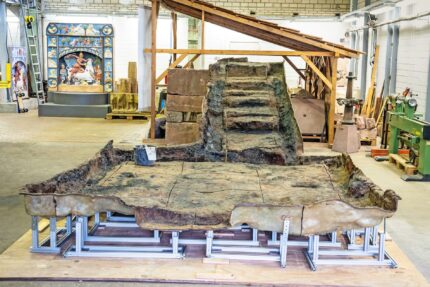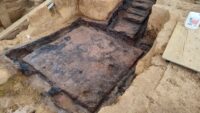 A Roman wooden cellar complete with five-step staircase in an exceptional state of preservation has been discovered in Frankfurt and recovered. Dating to the late 1st century, the cellar is all that remains of a half-timbered Roman residential building which burned down in a fire. Roman cellars were not like basements today, but rather underground storage rooms formed by beams along the sides and boards on the floor. The beams and boards survived the millennia because they were carbonized by the flames.
A Roman wooden cellar complete with five-step staircase in an exceptional state of preservation has been discovered in Frankfurt and recovered. Dating to the late 1st century, the cellar is all that remains of a half-timbered Roman residential building which burned down in a fire. Roman cellars were not like basements today, but rather underground storage rooms formed by beams along the sides and boards on the floor. The beams and boards survived the millennia because they were carbonized by the flames.
The cellar was unearthed by a team from the Frankfurt Monuments Office in the Heddernheim district of northwest Frankfurt, in March of 2023. Founded as a civilian settlement attached to a series of fortresses established by Augustus during his German campaigns, modern-day Heddernheim was the ancient city of Nida. It was made the capital of the Civitas Taunensium area by the emperor Trajan in In 110 A.D. and at its peak had a population of 10,000. It was gradually abandoned starting around 260 A.D. under pressure from the invading Alemanni confederation. Its ruins above ground were visible until the 15th century when they were pillaged for construction materials. Most of the underground remains were all but destroyed during real estate developments in the 20th century.
 Few structures from ancient Nida have been found in excavations, and while the remains of wooden cellars have been found over the past century, they were not well-preserved and the technology to conserve and study them didn’t exist then. This cellar’s size and preservation are so extraordinary it is the best preserved remnant of the ancient city. It will give researchers a unique opportunity to learn about Roman Nida.
Few structures from ancient Nida have been found in excavations, and while the remains of wooden cellars have been found over the past century, they were not well-preserved and the technology to conserve and study them didn’t exist then. This cellar’s size and preservation are so extraordinary it is the best preserved remnant of the ancient city. It will give researchers a unique opportunity to learn about Roman Nida.
![]() As soon as it was exposed to the elements, the cellar was in danger, so the floor, side beams and staircase were removed in a complex operation. The whole kit and caboodle weighed 50-60 tons, so it could not be raised whole, and as soon as any part of the soil around it dried out, the wood could have cracked. The team took an innovative approach. First they sprayed on a layer of synthetic resin, then a separating layer of silicone rubber and a final top layer of plaster to fix the surface. The cellar was then cut into 33 blocks to transport them to the restoration workshop of the Archaeological Museum Frankfurt.
As soon as it was exposed to the elements, the cellar was in danger, so the floor, side beams and staircase were removed in a complex operation. The whole kit and caboodle weighed 50-60 tons, so it could not be raised whole, and as soon as any part of the soil around it dried out, the wood could have cracked. The team took an innovative approach. First they sprayed on a layer of synthetic resin, then a separating layer of silicone rubber and a final top layer of plaster to fix the surface. The cellar was then cut into 33 blocks to transport them to the restoration workshop of the Archaeological Museum Frankfurt.
 At the museum, restorers removed the soil from the back and underside of the wood and reinforced the base with fiberglass. This was the first time this technique has been used. The conserved cellar was shown to the press, but there are no plans to put it on public display. Museum officials would prefer to return it to its original context, but it is a building plot privately owned by housing developers, so they’re considering creating an archaeological park nearby where the cellar and other finds made since construction began in 2021 (hypocaust heating, pottery kilns, a public latrine) could also be displayed.
At the museum, restorers removed the soil from the back and underside of the wood and reinforced the base with fiberglass. This was the first time this technique has been used. The conserved cellar was shown to the press, but there are no plans to put it on public display. Museum officials would prefer to return it to its original context, but it is a building plot privately owned by housing developers, so they’re considering creating an archaeological park nearby where the cellar and other finds made since construction began in 2021 (hypocaust heating, pottery kilns, a public latrine) could also be displayed.
This German language video gives a great overview of the site and the additional finds made in the cellar.